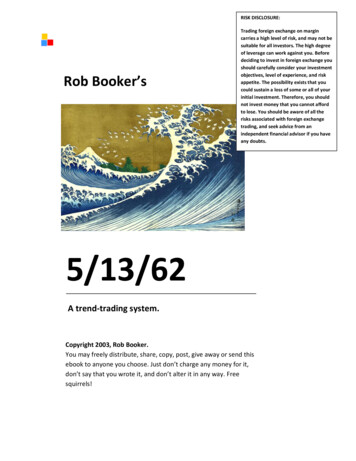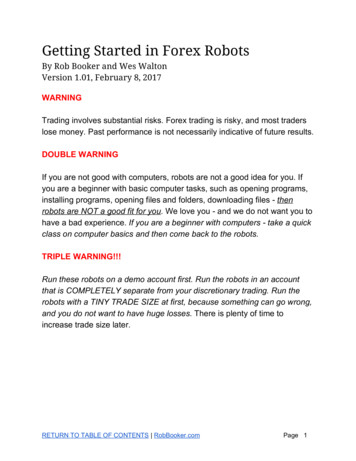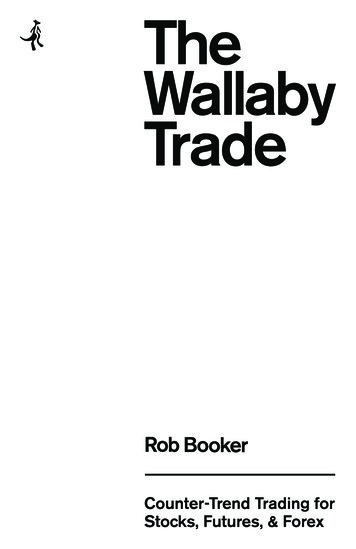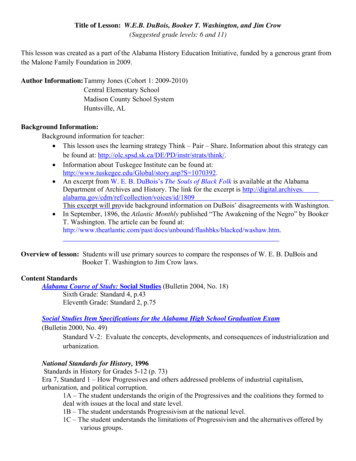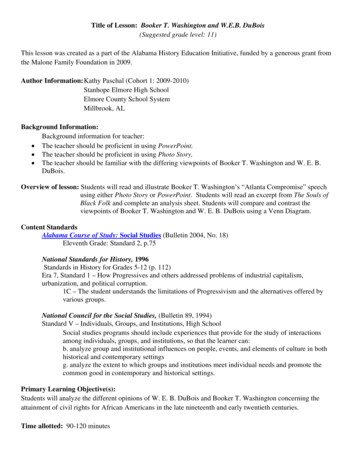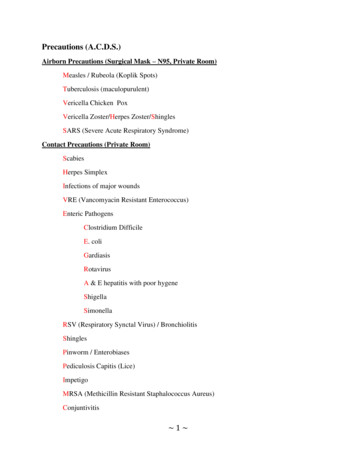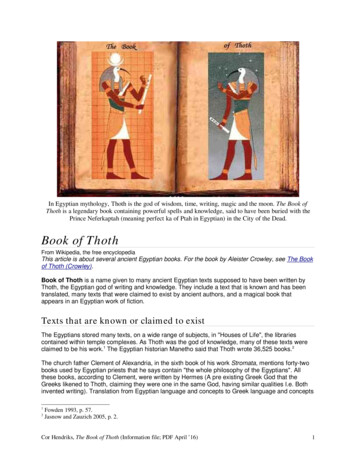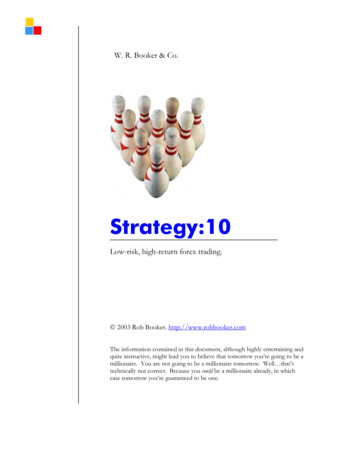
Transcription
Strategy: 10Rob Booker
About the AuthorRob Booker is a trader, author, and speaker. He has spoken to thousands of traders around the world,and is the author of books about the currency markets, and the creator of the web site RobBooker.com,where he shares thoughts about the market, trading stratagies, and more. Most of what he offers isfree. Rob is also a (pending as of June 2010) Commodities Trading Advisor, registered with the NationalFutures Association, and manages money in the currency markets. His account statements are generallymade public on a regular basis, and you can see them at:http://RobBooker.com
Somewhat Defective Table of ContentsIntroductionPart One: Where I Talk to the Currency Market Like It's a PersonPart Two: What Bears Have and Hikers Can Teach Us About TradingPart Three: Can You Live From 10 Pips Per Trade?Part Four: Final Thoughts and a ChallengeIt’s very possible that this table of contents doesn’t work in the Kindle edition. That’s because I’m acurrency trader, not a Kindle programmer, and after an hour of hand-to-hand combat with text editors,HTML file importers, and .mobi extensions, I nearly through –UGH. I mean threwmy computer (and myself) out the window. So if this table of contents is just a list of unclickable items,then I want to be the first to tell you: so what. The ebook isn’t that long, and it’s fun to read. So getgoing!
IntroductionStrategy: 10 is the first e-book I ever wrote. And it’s still the most popular, and has been downloadedover 500,000 times - I lost count after that number. It's now available in Japanese, Persian, Italian, andeven something called "Canadian," though I'm not sure that's a language. I wrote this ebook it because Iwas worried that people just starting out in the business of trading currency (forex) were going to dowhat I did when I started: look only for the big win. And in only looking for the big win, they'd setthemselves up for disappointment. In the year 2000, when I started, I missed out on hundreds andhundreds of profitable trades because my focus was in the wrong place. I could have been makingmoney, banking it, making money, banking it, repeatedly: but instead, I was holding out for the lotteryticket-style win, the big trade, the one that I could brag about.All that changed after I lost my first account, and I changed my perspective. This litte book is a guide tothinking differently about the currency markets, about trading, and for that matter, about life.I'm very grateful for your time and attention. Enjoy!
Part One: Where I Talk to the Currency Market Like It's a PersonWhen I first started trading, 10 years ago, I had a conversation with a stock broker in San Francisco:ME: I am thinking of doing some trading in the markets.BROKER: Well, you should stay away from the currency markets. That's some crazy sh**.ME: Thanks for the advice.And then I promptly went out and opened a trading account with a forex broker.I looked first at the US Dollar against the Japanese Yen (USD/JPY). The charts were ridiculous! Thecurrency pair was moving all over the place. On closer inspection, I realized that it was moving hundredsof points (called "pips") in just a day sometimes. Obviously, my broker friend didn't know what he wastalking about. This currency market stuff was perfect for me. It had all the first-class qualities that Ilooked for in an opportunity:1. Preposterously volatile.2. Huge opportunity to make massive profits in short periods of time.3. Easy to start with a small investment.Of course, you what happened next: I opened a trading account, and went for the big moves. If theUSD/JPY was going to fly up or down 100-300 pips in one day, I was going to catch the full move. I wouldnot be satisfied with anything less. When reading about trading online, I latched onto the people whoposted the most often in brand new discussion boards - and they all said the same thing: your profittarget has to be bigger than your stop loss. Meaning, every time I took a trade, my goal for profit had tobe larger than my limit for the loss on the trade. That way, I could "survive longer" in the markets, Icould endure a string of losses before I had a win, and I'd be obeying the sacred "Risk to Reward" ratiorules, which basically said that I should always risk less than I stood to gain on a trade.How reasonable! What impeccable logic! Immediately I started a conversation in my head with themarket:ME: Hello, currency market. It's me, Rob Booker. I'm ready for my untold wealth and riches.CURRENCY MARKET: I don't know you. I am going to eat you for lunch.I didn't listen.The defining characteristic of my strategy was to have the best Risk to Reward Ratio (you should playsome sort of somber religious theme music when you read that phrase in this little book). The best wayto do that was to take a trade - and then, set no profit target at all. What I wanted to do was have the
market go 1,000 pips in my direction. I'd seen what the currency market could do. And if it moved 1,000pips in my direction, then my winners would always be larger than my losses. What a genius idea, right?It took me three weeks to blow up that first account. Two thousand five hundred dollars down the drain.And it really wasn't even three weeks. It was actually two and a half weeks of making money, and thenBOOM: in three days, I lost the account. How did I do it? It was easy:1. I took a trade on the USD/JPY.2. I set no profit target. Over the course of the first day in the trade, the trade was positive 40, 50,even maybe 60 pips. That's a fine win. But I didn't take it.3. The pair then moved against me, and fell, and fell, and fell, and I didn't close it. It had neverfallen that far before!4. It then fell further than I'd ever seen it go in my illustrious three week trading career. So far, infact, that the losses overwhelmed my account balance, and the broker automatically closed mytrade in what is called a "Margin Call."You're smarter than me, so you already know what the lesson is: if you have a reasonable gain on atrade that's open, there isn't any shame in closing it. It's easier for the market to move 10, 20, 30 pips inthe direction of your trade (and make you money) than it is for the market to move 100, 200, or 300points in your direction. Huge trends do happen in the currency markets. But they can hurt you as muchas they can help you.Please bear with me while I repeat the above in a different way: there are not many 100-pip trades justwaiting for you. If it were easyt to take 100-pip trades, or 1,000 pip trades, we'd all be at a party in theHollywood Hills with Ashton Kutcher and Demi Moore right now, instead of sitting around looking atcharts.When I realized that many traders were looking for huge wins, but ending up with huge losses, I turnedmy strategy around. I stopped looking for the big score.I simply looked for 10-pip trades. Getting in and out of the trade after 10 pips was a lot easier thanlooking for the big winner. It was less stressful. And I was able to find far more methods for grabbing 10pips than I was for getting 100. In fact, I could change my methods around and be flexible, and themarket was, well, more cooperative.Over the years I have altered the strategy to fit different market conditions and different currency pairs.For example, it's not just about getting 10 pips. That's a good start. But it's not just about that. You cando more than that, you can actually do way more than that. But if you start with a modest goal in mind,you might find that you are much happier. And when you've banked 10 pips - and your account balancehas made a slight bounce in the upward direction - then you have choices. Choices are good. Once youhave 10 pips, you can:
1. Set a stop loss on your trade to exit the trade if the pair moves 10 pips against you, and you'lljust get out with zero gained, zero lost. But if it goes farther in your favor, you can make morethan 10 pips. Then you can keep moving your stop loss as the pair moves in your favor, to lock inmore profit. That's called a trailing stop loss.2. Take the 10 pips. Bank them. They are now yours.3. Dance. Just dance.If you do this when you’re first starting out, you’re going to get a good mix of 10-pip winners, 15- to 30pip losers, break-evens, and 20- to 100-pip winners. Yes, you're going to be able to capture some ofthose big moves.But where do you set your stop? How do you know when to take your profit? I can hear the wheelsspinning in your brain. So let’s get down to business.We’ll start with a story.
Part Two: What Bears and Hikers Can Teach Us About TradingA bear was chasing two hikers. During the chase, one hiker stopped to put on running shoes. As he waschanging out of his hiking books, his companion looked at him in horror and yelled, “What in the worldare you doing? You’ll never outrun the bear if you stop now!” Calmly, the other hiker replied, “I don’thave to outrun the bear. I just have to outrun you.” Then he winked and raced off.Here is an image depicting the two hikers above:It's taken from the Japanese version of the book you're reading right now. I love how the scared hiker isscreaming, "Holy gosh! I'm going to be eaten." I don't know why that makes me laugh. But it does, everytime.Currency trading can be like running from a bear. Trading offers more opportunity for fast financialsuccess — and financial ruin — than almost any other profession. The get-rich crowd has always beenattracted to it. This group includes speculators, trading novices, me when I started trading, retirees, and
professionals looking for a way to get out of debt, increase the excitement in their lives, or to pay forplastic surgery.Up until now, this group might have also included you. But from now on, instead of being a member ofthis crowd, you’ll helping these people by telling them what you've learned. You won't be taking moneyaway from these people (that's not how the market works) but you certainly won't be experiencing thesame kind of horrific losses like they do. Remember: they are the people who will be eaten by the bear.You don’t have to outrun the bear (the entire market). In fact, that’s impossible. You can’t beat theentire market, but you can trade defensively, and by so doing, position yourself to profit consistently.First we need to look at the four groups of currency traders, and find out which group you’re in.The Four GroupsThere are four types of participants in currency trading: the novice traders, the dealers, the institutionaltraders, and the advanced retail traders. This is a ridiculous simplification of the players in the world offorex - but these are the only groups we care about right now.Novice traders. The novice traders are the greenies, the ones who try to outrun the bear and lose, everytime. We all start here.Dealers. In all trading, the dealers are the most powerful, and they make the market by setting pricesand putting together deals for you. A dealer is not the final resting spot for your trade - the dealer mightpass it on to an institution (see below) but as far as you're concerned, the dealer is where the tradestarts and stops. A "no dealing desk" dealer is a dealer who claims that you're not trading with thedealer, but they are actually simply acting as the middleman in your trade, as they match you withanother trader or a bank. If you lose on your trade with a "no dealing desk" broker, the broker gets atransaction fee (a rebate) for matching up the order, but the person or institution on the other side ofthe trade gets the money from your loss. A "dealing desk" broker is one that may or may not offset thetrade in this manner - they might simply hold onto the trade you took, betting that you are going to lose.If you lose on your trade with a "dealing desk" broker, the broker gets the money. There is a lot ofdebate in the retail forex world about the differences between "dealing desk" and "no dealing desk"brokers, but it's really a semantic debate, and matters a whole lot less than people think it does.Institutions. Although institutional traders move more money around than dealers, you need toremember that your dealer is still the one who either accepts or rejects your orders each time you trade.An example of an institutional trader is a major Wall Street bank - and they have rows of desks wheretraders pick up the phone and take orders for currency from major companies. Your retail currencybroker has an account with several institutions - and these institutions give them a line of credit, or anaccount, and allow your retail broker to trade with you and thousands of other people - and then in turnthe broker trades with the institution.
These institutions people trade huge amounts of money at a time, and the size of their trades givesthem enormous power. Some of these traders are moving 1 billion in currency — or more — per hour.Some of these people are trading tens of billions of dollars every minute in the most active times in themarket.Advanced retail forex traders . This group is comprised of people from all across the world, sitting insmaller investment firms, offices, or even their homes. Eventually you want to be a part of this group.In some cases, the advanced traders are the smartest group, trade for trade, than any other group,because they don’t move a lot of money on each trade. Of course, they don’t have as much power asthe institutional players. And because their trades are brokered by the dealers, they’ll never haveabsolute price-setting power.But that doesn't matter. Trade for trade - and I have seen millions of trades placed by thousands of retailforex traders - these "non professional" traders can place extremely profitable trades, over and overagain.[Note: For a short time, I was the Chief Market Strategist for a major retail currency dealer in theUnited States. I had access to see every trade placed in every account, twenty-four hours perday. One amazing trend that I noticed was that retail currency traders, on the whole, madeexcellent decisions about the direction of the market, but did a horrible job of managing theirrisk: they would place trades that could easily get 10, 20, or 30 pips, but they would let themturn into losses. They had the direction of the market right but, wow! They were losing moneyanyway.]Don't feel bad about the fact that as you make money, there are lots of other people out there losingmoney. Someone’s going to take your money along the way, too, and it’s going to teach you — veryquickly — lessons that can only be learned through failure.So every time you take money from a novice trader, just remember: You’re teaching him or her avaluable lesson. After a while, you might even enjoy watching your hiking companion being eaten by thebear. Well, you might not enjoy it, but you’ll deserve every pip you earn.That came out all wrong. I can't believe I presumed you would be interested in seeing a person eaten bya bear. I take it back. Okay, not really. I don't take it back at all. All I care about is that you don't geteaten by the bear. There, I said it.
Part Three: Can You Live Off 10 Pips Per Trade?In the currency market, you can trade standard lots, mini lots, or micro lots.One standard lot is equal to 100,000 in currency, and it generally costs you about 1,000 in margin(down payment, if you will) to place that trade. For every 1pip the market moves in one direction, yougain or lose 10.One mini lot is equal to 10,000 in currency, and will set you back 100 to take the trade. As the marketmoves 1 pip for or against you, you make or lose 1.A micro lot is a perfect way to start trading. It's equal to 1,000 in currency, costs you just 10 in marginto open the trade, and you gain or lose just 10 cents as trades move in your favor or against you.If you eventually work up to the point where you are trading 1,000,000 worth of currency, which is 10standard lots, each movement would be equal to 100. So if you bought the Euro against the US Dollar(EUR/USD) at 1.1445 and sold at 1.1545, you would make 100 pips.100 pips multiplied by 100 equals 10,000. Now, I don’t know about you, but I could live off that much.That’s not saying, however, that you can make 10,000 per day. Of course it’s possible, but there are alot of factors that make it considerably difficult at the start, and easier over time as you learn moreabout trading. But let's just say that 10 pips a day is not an unreasonable goal, and can mulitply overtime very quickly.Is it reasonable to think you can make 100 pips a day? Probably not. Most people try to do that, andmost people get eaten by the bear.But what about 10 pips? Could you do that? Some gains, some losses? Compounding gains is thegreatest financial invention in the history of the world. Richard Russell, who writes the Dow TheoryLetter, said that a long time ago, and I've never forgotten it.If you traded 1 standard lot, and made 10 pips a day, and had a 10,000 trading account, and increasedyour trading size over time, here is what the growth would look like:
That looks good enough for me. Of course, you're going to go through some rough times: you are notgoing to make 10 pips every single day, and I've mentioned if before (and I will again) - some days you'regoing to lose money. But taken as a whole, you can probably average 10 pips a day if you put the timeand effort into learning how to do it.For a spreadsheet on how all of this is calculated, just email me at rob@robbooker.com, and put "10 pipspreadsheet" in the subject line.You might ask yourself these questions before trading:When should I get in a trade?Where should I place my stop-loss?What happens if something goes wrong?Even more importantly, can you deal with the emotions of forex trading? The psychology of trading ismore difficult to master than anything else - more that the charts, more than the money management,more than the economics.GreedMost traders in the forex market try to make a zillion dollars on every trade. They’re greedy. This leadsthem to stay in a good trade, hoping to get more money out of it. Staying in a trade too long because of
greed can lead to disaster — the trade can move against them, and they get creamed. This happens allthe time, and it still happens to me from time to time. Greed is the single greatest threat in trading.But you can already understand why that’s probably true. So how does one overcome greed whiletrading? We'll talk about that in just a moment.RevengeThis is the other big one. A lot of traders flush some pips down the toilet and then want to strike back.So they double their last order and go for broke. This is like, well it’s like reaching down into yourtoilet. That’s gross. And it does not make you any richer.The impulse to get revenge is natural, and I still deal with this emotion often. Don’t underestimate thisemotion. Many traders have not only reached into the toilet of revenge, they have dived into it headfirst. Every time you are tempted to jump into the market and "grab back" what you just lost, imagine acolorful, movie-sized screen in your mind, depicting you diving headfirst into a messy toilet. That oughtto do the trick.Remember, the market is not your friend. The market is so much more powerful than you are. Youcannot “get back at” the market. Trading when angry or vengeful will be a total disaster. If you take a bigloss, then stop, take a deep breath, and talk to a mentor or your mirror, or your favorite stuffed animal.Reread the charts. Take a break. Chew on your toe if you have to. Even if you think you see the bestopportunity in the world after you get blasted, make sure you take a deep breath and pause before youdo anything.ME: Dear currency market, why do you do terrible things to me?CURRENCY MARKET: That's what I do.ME: Oooohhhh, you make me so angry!CURRENCY MARKET: That's what I do. Why don't you come and get me if you're so mad?ME: Nah, it's okay. You're kind of like a messy to
Rob Booker is a trader, author, and speaker. He has spoken to thousands of traders around the world, and is the author of books about the currency markets, and the creator of the web site RobBooker.com, where he shares thoughts about the market, trad
